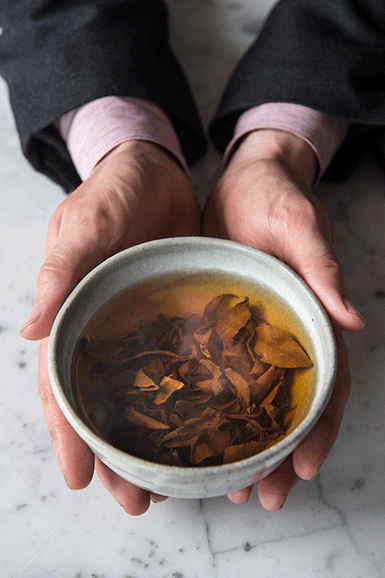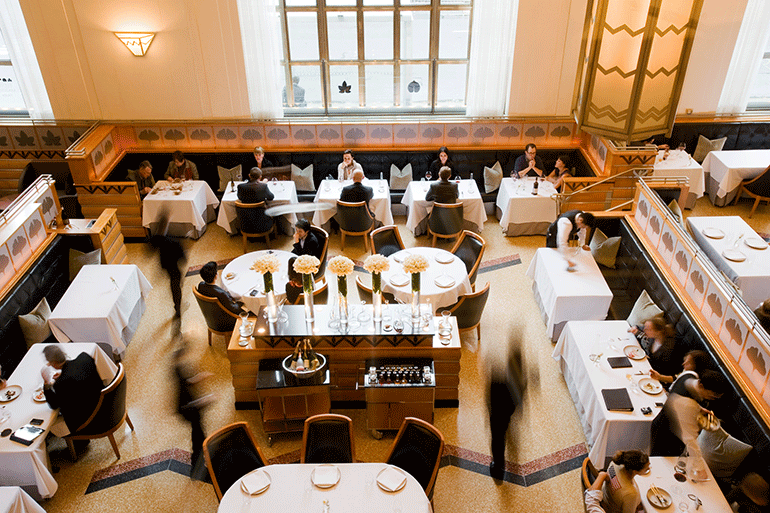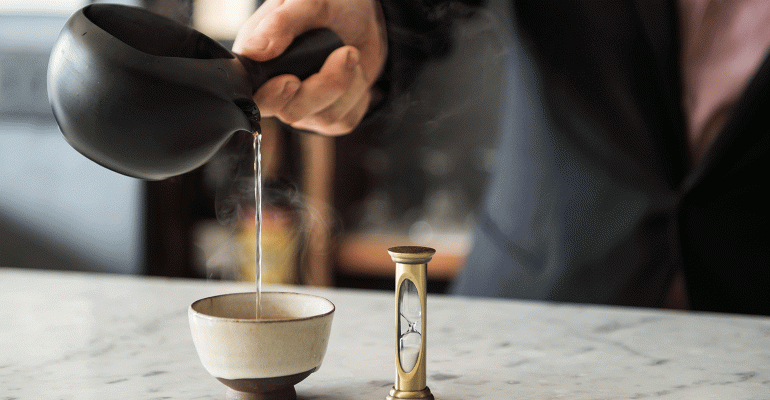In 2012, Jeff Ruiz looked out onto the massive, sprawling expanse that is New York’s dining scene. What stared back at him was an inexcusable void.
“It kind of hit me one day. In New York City all these resturants aim to have the best service, the best wine list, the best coffee etc., across the board,” said Ruiz, now the beverage director at the restaurant Olmsted in Brooklyn. “I didn’t see people trying to supply the best tea.
“It was an afterthought,” Ruiz continued. “A niche that hadn’t been filled.”
Across the coffee-drinking U.S., tea is on the rise.
According to a recent report on the 2016 tea market by Mintel, tea sales across all segments were projected to grow by 30 percent by 2021.
Part of that expected growth was attributed to growing interest in both ready-to-drink tea options and interest in more healthful beverage choices in general.
Mintel pointed to teas containing the “breakout ingredient” turmeric and the antioxidant-laden matcha style as top draws.

Jeff Ruiz holds a cup of tea
Across both the grocery and retail/restaurant markets, coffee consumption currently remains stronger than tea. The former is credited with being the main driver of the $21.6 billion sales numbers produced by the coffee house sector in 2016, but tea was also a contributor.
During the summer months, tea rides a wave of ready-to-drink options to come closer to coffee’s consumption rates.
In June 2015, 80 percent of consumers responding to a Mintel poll said they had imbibed a tea beverage within the previous three months. This was the closest the category would come to coffee’s popularity (82 percent) between the previous December and the spring of 2016.
It was three years prior to these stats that Ruiz first began to question tea’s absence from the spotlight. In 2012, he was working at the Manhattan restaurant Atera, an eatery that labels itself as an “immersive sensory dining experience.”
Atera offers a prix fixe menu for $275 per person, and an additional $175 per head with wine pairing.
Now, thanks in large part to Ruiz, guests can also opt for a standalone tea progression at a rate of $95 per person.
“I pioneered doing it at Atera,” Ruiz said. “I pretty much set out to have the best tea program in the country and one of the best in the world.”
Ruiz contends that when tea is served correctly it can rival the role wine can play in a fine-dining experience.
“At one of my first tastings I had a cup that had been made by someone who knew what they were doing. It was life changing. What was happening in that cup rivaled some of the more spectacular wines that I had ever tasted,” Ruiz said.
A large part of the service’s draw was the elaborate presentation, which is performed tableside.
While preparing matcha tea for guests, Ruiz described in detail every action of the 800-year-old procedure. After thoroughly muddling the fine powder that is a signature of the style, he invited his guests to smell it before it was steeped. During these presentations, the attention to detail for each component of the drink goes far beyond simply adding a bag of assorted leaves to hot water.
“Right now, multi-Michelin-starred houses are the first venues that are at the forefront of introducing higher-end leaf to a growing audience,” he said.
“The downside to that is only the folks who can afford that experience are getting the scoop on the amazing leaf out there,” he added. “That’s why what we’re doing with high-end teas at Olmsted is so important. We expose the casual neighborhood restaurant crowd to tea that can change the paradigm. Essentially, there is a ton of interest out there that still that has not yet been capitalized on.”
Earning a nod from The New York Times for putting together Olmstead’s wine list, he now has a mission to bring tea to the masses. Ruiz took the methods he honed at Atera and modified them to work in the more-casual Olmstead setting.
He pointed to tea selections that clock in at $4 per service. They include green selections such as karigane 22 and houjicha, a tisane option, multiple oolong choices and more.
“To us, tea is an everyday beverage made for anyone and everyone,” he said. “We want to make everything in the restaurant super available and not price-point prohibitive.”
Outside New York, the Hakkasan Group is also reviving interest in tea with the Yauatcha concept, which includes two domestic locations, in Las Vegas and Houston.
Yannick Augy, director of restaurant projects for the London-based Hakkasan Group, found inspiration from ancient times for its innovation with tea.
“Thousands of years ago, travelers along the ancient Silk Road through China needed a place to rest during their journey. In response, teahouses opened up along the roadside of Southern China,” he said.
Yauatcha is billed as a “modern tea house,” which pairs “accessible high-quality dining experiences” with a selection of 24 teas.
The restaurant’s offerings include Dragon Well green tea, cedarburg rooibos infusion, and pacific peppermint infusion, which range from $7 to $8 per pot.
Augy said that even guests that don’t consider themselves tea drinkers enjoy the “revitalizing, re-invigorating presence” that their tea menu aims to offer.
Meanwhile, back in New York, Eleven Madison Park, offers an equally immersive tea experience.

Eleven Madison Park in New York offers an immersive tea experience.
Eleven Madison Park, for example, in 2014 began offering a pu’er-style tea selection that had been fermenting inside of a bamboo capsule since the 1980s.
Those who selected this option were treated to a tableside lesson on the science behind the oxidation of teas, including pu’er, followed by the dissection of the bamboo capsule and the beginning of a modified gonfu tea ceremony. The leaves were rinsed, and allowed to breath before being mixed with the contents of a transparent kettle of boiling water.
“We wanted to elevate the guest’s experience with the show and interactive elements of tableside preparations,” said Sueyoung Jo, who currently heads the restaurant’s tea program. “We are always trying to engage our guests at a personal level and this was one way that we felt that we could talk to our guests about our culture and what their preferences might be about things like tea.”
Eleven Madison Park’s exclusive tea supplier also participates in training.
“We offer tea classes at the restaurant, taught by Pursuit of Tea, where our staff learns about the history of tea, the origin of the tea leaves, the science behind different styles of tea, the health benefits, the different brewing techniques and the list goes on and on,” Jo said.
Demand for tea “was underestimated by restaurateurs and hot beverage houses alike for a long time,” Ruiz said when discussing the future of tea as a draw. “But it has been slowly catching on.”
Time will tell if demand will continue to steep.





